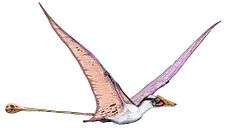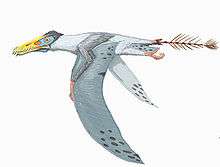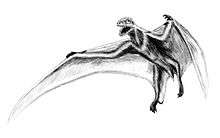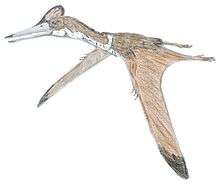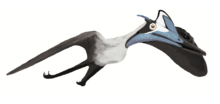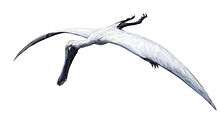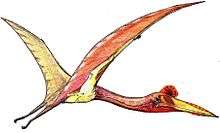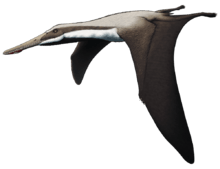Azhdarchidae
Azhdarchidae (from the Persian word azhdar (اژدر), a dragon-like creature in Persian mythology) is a family of pterosaurs known primarily from the late Cretaceous Period, though an isolated vertebra apparently from an azhdarchid is known from the early Cretaceous as well (late Berriasian age, about 140 million years ago).[1] Azhdarchids included some of the largest-known flying animals of all time, but members no larger than a cat have also been found.[2] Originally considered a sub-family of Pteranodontidae, Nesov (1984) named the azhdarchinae to include the pterosaurs Azhdarcho, Quetzalcoatlus, and "Titanopteryx" (now known as Arambourgiania). They were among the last known surviving members of the pterosaurs, and were a rather successful group with a worldwide distribution. By the time of the end-Cretaceous mass extinction, most pterosaur families except for the Azhdarchidae disappear from the fossil record, but recent studies indicate a wealth in pterosaurian faunas, including pteranodontids, nyctosaurids, tapejarids and several indeterminate forms.[3] Some taxa like Navajodactylus, Bakonydraco and Montanazhdarcho were moved from Azhdarchidae to other clades.[4][5][6]
| Azhdarchids | |
|---|---|
| Reconstructed skeleton of Quetzalcoatlus northropi | |
| Scientific classification | |
| Kingdom: | Animalia |
| Phylum: | Chordata |
| Order: | †Pterosauria |
| Suborder: | †Pterodactyloidea |
| Clade: | †Neoazhdarchia |
| Family: | †Azhdarchidae Nesov, 1984 |
| Type species | |
| †Azhdarcho lancicollis Nesov, 1984 | |
| Genera | |
| Synonyms | |
| |
Description

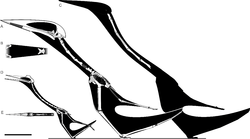
Azhdarchids are characterized by their long legs and extremely long necks, made up of elongated neck vertebrae which are round in cross section. Most species of azhdarchids are still known mainly from their distinctive neck bones and not much else. The few azhdarchids that are known from reasonably good skeletons include Zhejiangopterus and Quetzalcoatlus. Azhdarchids are also distinguished by their relatively large heads and long, spear-like jaws. There are two major types of azhdarchid morphologies: the "blunt-beaked" forms with shorter and deeper bills and the "slender-beaked" forms with longer and thinner jaws.[7]
It had been suggested azhdarchids were skimmers,[8][9] but further research has cast doubt on this idea, demonstrating that azhdarchids lacked the necessary adaptations for a skim-feeding lifestyle, and that they may have led a more terrestrial existence similar to modern storks and ground hornbills.[10][11][12][13][14] Most large azhdarchids probably fed on small prey, including hatchling and small dinosaurs; in an unusual modification of the azhdarchid bauplan, the unusually robust Hatzegopteryx may have tackled larger prey as the apex predator in its ecosystem.[15] In another departure from typical azhdarchid lifestyles, the jaw of Alanqa may possibly be an adaptation to crushing shellfish and other hard foodstuffs.[16]
Azhdarchids are generally medium- to large-sized pterosaurs, with the largest achieving wingspans of 10–12 metres (33–39 ft),[17] but several small-sized species have recently been discovered.[18][19] Another azhdarchid that is currently unnamed, recently discovered in Transylvania, may be the largest representative of the family thus far discovered. This unnamed specimen (nicknamed "Dracula" by paleontologists), currently on display in the Altmühltal Dinosaur Museum in Bavaria is estimated to have a wingspan of 12–20 m (39–66 ft), although similarities to the contemporary azhdarchid Hatzegopteryx have also been noted.[20]
Systematics
Azhdarchids were originally classified as close relatives of Pteranodon due to their long, toothless beaks. Others have suggested they were more closely related to the toothy ctenochasmatids (which include filter-feeders like Ctenochasma and Pterodaustro). Currently it is widely agreed that azhdarchids were closely related to pterosaurs such as Tupuxuara and Tapejara.
Taxonomy
Classification after Unwin 2006, except where noted.[21]
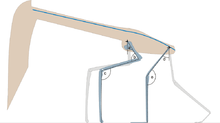
- Family Azhdarchidae
- Aerotitan
- Alanqa[22]
- Aralazhdarcho[23]
- Arambourgiania
- Azhdarcho
- Cretornis[24]
- Eurazhdarcho[25]
- Hatzegopteryx
- Mistralazhdarcho[26]
- ?Montanazhdarcho (non-azhdarchid azhdarchoid, probably a tapejarid)[4]
- "Ornithocheirus" buenzeli[24]
- Palaeocursornis
- Phosphatodraco
- Quetzalcoatlus
- Volgadraco[27]
- Zhejiangopterus
- Possible valid azhdarchid genera
- ?Argentinadraco (azhdarchoid, tentatively classified as an azhdarchid)[28]
- Bennettazhia
- Bogolubovia
- ?Navajodactylus
Phylogeny
The most complete cladogram of azhdarchids is presented by Longrich et al. (2018):
| Azhdarchidae |
| |||||||||||||||||||||||||||||||||||||||||||||
In the analysis, they recovered Aerotitan and Alanqa as thalassodromids, Bennettazhia as a close relative of tapejarids, and Cretornis and Volgadraco as nyctosaurids.[29]
References
- Dyke, G.; Benton, M.; Posmosanu, E.; Naish, D. (2010). "Early Cretaceous (Berriasian) birds and pterosaurs from the Cornet bauxite mine, Romania". Palaeontology. 54: 79–95. doi:10.1111/j.1475-4983.2010.00997.x.
- Cat-Size Flying Reptile Shakes Up Pterosaur Family Tree
- Agnolin, Federico L. & Varricchio, David (2012). "Systematic reinterpretation of Piksi barbarulna Varricchio, 2002 from the Two Medicine Formation (Upper Cretaceous) of Western USA (Montana) as a pterosaur rather than a bird" (PDF). Geodiversitas. 34 (4): 883–894. doi:10.5252/g2012n4a10. Archived from the original (PDF) on 2013-01-15.
- Carroll, N. REASSIGNMENT OF MONTANAZHDARCHO MINOR AS A NON-AZHDARCHID MEMBER OF THE AZHDARCHOIDEA, SVP 2015
- Andres, B.; Myers, T. S. (2013). "Lone Star Pterosaurs". Earth and Environmental Science Transactions of the Royal Society of Edinburgh. 103 (3–4): 383–398. doi:10.1017/S1755691013000303.
- Wilton, Mark P. (2013). Pterosaurs: Natural History, Evolution, Anatomy. Princeton University Press. ISBN 978-0691150611.
- Witton, M. P. (2013). Pterosaurs: Natural History, Evolution, Anatomy. Princeton University Press.
- Nesov, L. A. (1984). "Upper Cretaceous pterosaurs and birds from Central Asia". Paleontologicheskii Zhurnal. 1984 (1): 47–57. Archived from the original on 2009-01-05.
- Kellner, A. W. A.; Langston, W. (1996). "Cranial remains of Quetzalcoatlus (Pterosauria, Azhdarchidae) from Late Cretaceous sediments of Big Bend National Park, Texas". Journal of Vertebrate Paleontology. 16 (2): 222–231. doi:10.1080/02724634.1996.10011310.
- Chatterjee, S.; Templin, R. J. (2004). "Posture, locomotion, and paleoecology of pterosaurs". Geological Society of America Special Publication. 376: 1–64. doi:10.1130/0-8137-2376-0.1. ISBN 9780813723761.
- Ősi, A.; Weishampel, D.B.; Jianu, C.M. (2005). "First evidence of azhdarchid pterosaurs from the Late Cretaceous of Hungary". Acta Palaeontologica Polonica. 50 (4): 777–787.
- Humphries, S.; Bonser, R.H.C.; Witton, M.P.; Martill, D.M. (2007). "Did pterosaurs feed by skimming? Physical modelling and anatomical evaluation of an unusual feeding method" (PDF). PLoS Biology. 5 (8): e204. doi:10.1371/journal.pbio.0050204. PMC 1925135. PMID 17676976.
- Witton, Mark P.; Naish, Darren; McClain, Craig R. (28 May 2008). "A Reappraisal of Azhdarchid Pterosaur Functional Morphology and Paleoecology". PLoS ONE. 3 (5): e2271. Bibcode:2008PLoSO...3.2271W. doi:10.1371/journal.pone.0002271. PMC 2386974. PMID 18509539.
- Veldmeijer, Andre J.; Witton, Mark; Nieuwland, Ilja (2012). Pterosaurs. ISBN 9789088900938.
- Naish, D.; Witton, M.P. (2017). "Neck biomechanics indicate that giant Transylvanian azhdarchid pterosaurs were short-necked arch predators". PeerJ. 5: e2908. doi:10.7717/peerj.2908. PMC 5248582. PMID 28133577.
- Martill, D.M.; Ibrahim, N. (2015). "An unusual modification of the jaws in cf. Alanqa, a mid-Cretaceous azhdarchid pterosaur from the Kem Kem beds of Morocco". Cretaceous Research. 53: 59–67. doi:10.1016/j.cretres.2014.11.001.
- Witton, M.P.; Habib, M.B. (2010). "On the Size and Flight Diversity of Giant Pterosaurs, the Use of Birds as Pterosaur Analogues and Comments on Pterosaur Flightlessness". PLoS ONE. 5 (11): e13982. Bibcode:2010PLoSO...513982W. doi:10.1371/journal.pone.0013982. PMC 2981443. PMID 21085624.
- Martin-Silverstone, Elizabeth; Witton, Mark P.; Arbour, Victoria M.; Currie, Philip J. (2016). "A small azhdarchoid pterosaur from the latest Cretaceous, the age of flying giants". Royal Society Open Science. 3 (8): 160333. Bibcode:2016RSOS....360333M. doi:10.1098/rsos.160333. PMC 5108964. PMID 27853614.
- Prondvai, E.; Bodor, E. R.; Ösi, A. (2014). "Does morphology reflect osteohistology-based ontogeny? A case study of Late Cretaceous pterosaur jaw symphyses from Hungary reveals hidden taxonomic diversity" (PDF). Paleobiology. 40 (2): 288–321. doi:10.1666/13030.
- "World's largest pterodactyl skeleton goes on show in Germany". 2018-03-23.
- Unwin, David M. (2006). The Pterosaurs: From Deep Time. New York: Pi Press. p. 273. ISBN 0-13-146308-X.
- Ibrahim, N.; Unwin, D.M.; Martill, D.M.; Baidder, L.; Zouhri, S. (2010). Farke, Andrew Allen (ed.). "A New Pterosaur (Pterodactyloidea: Azhdarchidae) from the Upper Cretaceous of Morocco". PLoS ONE. 5 (5): e10875. Bibcode:2010PLoSO...510875I. doi:10.1371/journal.pone.0010875. PMC 2877115. PMID 20520782.
- Averianov, A.O. (2007). "New records of azhdarchids (Pterosauria, Azhdarchidae) from the late Cretaceous of Russia, Kazakhstan, and Central Asia". Paleontological Journal. 41 (2): 189–197. doi:10.1134/S0031030107020098.
- Averianov, A.O. (2010). "The osteology of Azhdarcho lancicollis Nessov, 1984 (Pterosauria, Azhdarchidae) from the Late Cretaceous of Uzbekistan" (PDF). Proceedings of the Zoological Institute of the Russian Academy of Sciences. 314 (3): 246–317.
- Vremir, M. T. S.; Kellner, A. W. A.; Naish, D.; Dyke, G. J. (2013). Viriot, Laurent (ed.). "A New Azhdarchid Pterosaur from the Late Cretaceous of the Transylvanian Basin, Romania: Implications for Azhdarchid Diversity and Distribution". PLoS ONE. 8 (1): e54268. Bibcode:2013PLoSO...854268V. doi:10.1371/journal.pone.0054268. PMC 3559652. PMID 23382886.
- Romain Vullo; Géraldine Garcia; Pascal Godefroit; Aude Cincotta; Xavier Valentin (2018). "Mistralazhdarcho maggii, gen. et sp. nov., a new azhdarchid pterosaur from the Upper Cretaceous of southeastern France". Journal of Vertebrate Paleontology. Online edition (4): (1)-(16). doi:10.1080/02724634.2018.1502670.
- Averianov, A.O.; Arkhangelsky, M.S.; Pervushov, E.M. (2008). "A New Late Cretaceous Azhdarchid (Pterosauria, Azhdarchidae) from the Volga Region". Paleontological Journal. 42 (6): 634–642. doi:10.1134/S0031030108060099.
- Kellner, A.W.A.; Calvo, J.O. (2017). "New azhdarchoid pterosaur (Pterosauria, Pterodactyloidea) with an unusual lower jaw from the Portezuelo Formation (Upper Cretaceous), Neuquén Group, Patagonia, Argentina". Anais da Academia Brasileira de Ciências (Annals of the Brazilian Academy of Sciences). 89: 2003–2012. doi:10.1590/0001-3765201720170478. PMID 29166530.
- Nicholas R. Longrich; David M. Martill; Brian Andres (2018). "Late Maastrichtian pterosaurs from North Africa and mass extinction of Pterosauria at the Cretaceous-Paleogene boundary". PLOS Biology. 16 (3): e2001663.
- Astibia, H.; Buffetaut, E.; Buscalioni, A.D.; Cappetta, H.; Corral, C.; Estes, R.; Garcia-Garmilla, F.; Jaeger, Mazin; Jimenez-Fuentes, J.J.; Loeuff, J. Le; Mazin, J.M.; Orue-Etxebarria, X.; Pereda-Suberbiola, J.; Powell, J.E.; Rage, J.C.; Rodriguez-Lazaro, J.; Sanz, J.L.; Tong, H.; et al. (1991). "The fossil vertebrates from Lafio (Basque Country, Spain); new evidence on the composition and affinities of the Late Cretaceous continental fauna of Europe". Terra Nova. 2 (5): 460–466. doi:10.1111/j.1365-3121.1990.tb00103.x.
- Bennett, S. C. (2000). "Pterosaur flight: the role of actinofibrils in wing function". Historical Biology. 14 (4): 255–284. doi:10.1080/10292380009380572.
- Nesov, L.A. (1990). "Flying reptiles of the Jurassic and Cretaceous of the USSR and the significance of their remains for the reconstruction of palaeogeographic conditions". Bulletin of Leningrad University, Series 7, Geology and Geography (in Russian). 4 (28): 3–10.
- Nesov, L.A. (1991). "Giant flying reptiles of the family Azhdarchidae: 11. Environment, sedirnentological conditions and preservation of remains". Bulletin of Leningrad Universitv Series 7, Geology and Geography (in Russian). 3 (21): 16–24.
